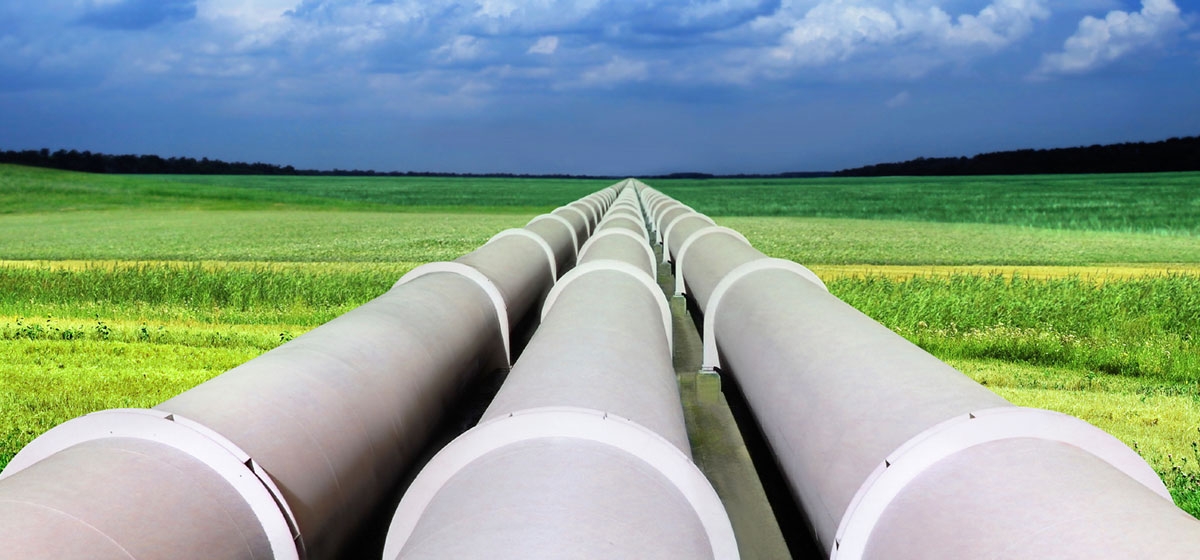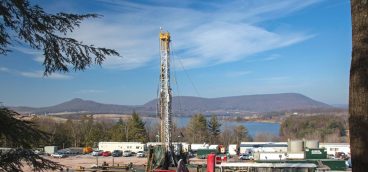The Future of the Marcellus Shale

After eight years of unprecedented expansion, the natural gas industry in Pennsylvania is now weighed down by its own success, analysts say. Struggling with a market that is being flooded with more natural gas than it can bear, the industry is optimistically predicting that new markets in transportation, home heating, chemical manufacturing and other industries will arise almost organically and restore some level of economic equilibrium.
But at the same time, the nation’s largest natural gas producers are casting a covetous eye overseas, to regions like Asia and Europe that have yet to experience their own natural gas booms and where demand remains high.
There is no question, analysts say, that the industry in Pennsylvania and elsewhere in the United States is at an inflection point.
Despite a modest rebound in natural gas prices from their historic lows below $2 per thousand cubic feet last spring, the market remains weak. By early June, prices were hovering around the $2.50 per thousand cubic foot range, roughly half what they had been in 2010, and a fraction of the price that natural gas fetched in 2007 when the drilling frenzy began.
The industry is trying to dial back from its breakneck pace of 2010, shifting its focus to liquid-rich gas in the western part of the state that can generate additional revenues through the sale of ethane and other components. It also is scaling back production in the dry gas regions, drilling only those wells that, for contractual or other economic reasons, absolutely have to be drilled. Even so, production continues to increase. As of June 1, the number of Marcellus wells that have been drilled in Pennsylvania had reached 6,931, with another 2,457 permitted.
Those wells produced a lot of gas.
According to the industry’s own calculations, the Marcellus alone is producing about 3 billion cubic feet of natural gas per day. The state produced a trillion cubic feet last year, and West Virginia pumped another 350 billion cubic feet into the nation’s overburdened pipelines during the same period. And with at least 10 other major gas fields across the nation on deck waiting to be developed, few analysts expect a sharp rebound in prices anytime soon. Even the most bullish proponents of natural gas as a commodity acknowledge that a real rebound in natural gas prices—large enough to spark the kind of economic growth that natural gas advocates have long promised—is still at least a year off, and maybe even more.
“As far as the downturn, I don’t know when that subsides. Some people think 2014, some think 2016,” said Matt Pitzarella, spokesman for Range Resources, one of the most active drillers in the Marcellus. Part of the decline can be blamed on the level of production, which continues to outstrip demand. But the natural gas market has also experienced a perfect storm of economic factors: an unseasonably warm winter in 2011–2012 that cut demand, and lingering effects of an economic downturn that even now, four years after the stock market’s fall, is still keeping growth sluggish, reducing demand for all the fuels of industry, including natural gas.
And even when and if the current depressed market rebounds, few expect that it will reach the heights of 2007, when natural gas flirted with historic highs around $13 per thousand cubic feet. Few, if any, analysts expect natural gas to break the $6 barrier in the foreseeable future.
There is, of course, a bright side to that overabundance. A decade after most industry analysts warned that the U.S. was in danger of running out of natural gas, the fuel produced from shales like the Marcellus has become so cheap and so plentiful that it has begun to supplant coal as the fuel of choice for generating electricity. Coal, which in 1985 was the fuel behind 57 percent of the electricity used in the U.S., plunged to a 37 percent share this year. And as long as gas prices remain low, at $2.75 per thousand cubic feet or less, most analysts expect that trend to continue.
But there are few analysts who expect that that trend, even if it continues, will be sufficient to support the kind of growth the industry—and the state, which is looking to the natural gas industry as a key pillar of future economic expansion—would like. “Utilities are not going to use that much, really,” says Ray Perryman, a Texas economist who has spent decades studying the natural gas industry. The way Perryman and other industry experts see it, if the natural gas boom in Pennsylvania and elsewhere is to continue, new markets will have to be developed.
To be sure, there have been some steps taken in that direction. Earlier this year, for example, Shell—lured not just by the region’s abundant natural gas supplies but also by a generous package of tax incentives offered by the Corbett administration—announced plans to build a billion-dollar ethane cracker on a 300-acre former zinc plant site near Monaca in Beaver County that would process valuable natural gas liquids from the Marcellus for use in the plastics industry. Ground could be broken on the project, which is expected to lure more manufacturing to the region, within two years, the company and state officials have said.
In the meantime, both the Obama and Corbett administrations have thrown their support behind proposals to expand the use of natural gas as a fleet fuel, backing state and federal subsidies to expand the number of service stations that can provide compressed natural gas, which burns 30 percent cleaner and is roughly half the price of diesel. Some companies have also taken the bit between their teeth. According to the Philadelphia Inquirer, the nation’s largest waste handler, Waste Management, has already switched 80 percent of its fleet in southeastern Pennsylvania to run on CNG, and it expects to build two more CNG refueling stations in the metropolitan Philadelphia area within the next two years.
At the moment, however, the transportation market is limited. There are few factory-built natural gas vehicles available. Honda makes one and both General Motors and Chrysler have announced plans to build natural gas-powered trucks, despite the fact that the comparatively small alternative fuel market remains competitive, with hybrid vehicles taking the lion’s share. Add to that the falling price of oil and conventional motor fuels this summer and the comparative dearth of natural gas refueling stations available, and few expect that natural gas vehicles will soon play a decisive role in the market.
The bottom line, Perryman says, is that for natural gas to really gain a foothold as a transportation fuel, it must win the imprimatur of the financial markets by persuading investors that it is here to stay.
“For that to happen we have to have vehicles… and what’s more important… we have to have the infrastructure for people to be able to pull in and refuel natural gas… and for that to happen, I think these costs have to be studied for a while—enough that the market’s willing to take a risk to do that,” he says.
Given the built-in obstacles, the natural gas industry lately has been exploring another potential alternative: export, says Diana Furchtgott-Roth, an economist with the conservative Manhattan Institute. “The big unknown is whether we’ll be able to export.”
There are a handful of proposals to build liquefied natural gas plants capable of exporting the vast cache of natural gas unleashed by the Marcellus to overseas markets where the demand—and the market price—is currently high. In Europe, for example, natural gas is trading four times higher than in the U.S. And Japan, which is still reeling from the loss of much of its nuclear power in the wake of last year’s devastating earthquake and tsunami, has already been importing record amounts of natural gas from the U.S., at prices that reached $16 a thousand cubic feet in the first quarter of 2012.
That’s a market the industry is eager to exploit, says Pitzarella of Range Resources, acknowledging growing opposition to developing export facilities. But he and other industry insiders contend that developing export capacity would be a boon not just to the region but to the countries on the receiving end as well.
“It will probably account for about 10 percent of the total production in the United States, just the ability to export alone,” he says, “and it will have an impact on the U.S. global stature, on energy policy as a whole. Exporting 10 percent of our natural gas—that’s 10 percent of a cleaner fuel in the global sense. If we have policies in this country that discourage the use of certain sources of fuel but we do nothing to curb that in India and China, it’s just a wasted argument.”
There is, however, little doubt that if gas from the Marcellus and other shale plays in the U.S. does become a global commodity—like oil, decoupled from domestic trading pressures and allowed to rise and fall with the global economic tides—prices here would be likely to rise even as they fall elsewhere.
What’s more, as the shale boom has expanded in the U.S., overseas companies from Europe and Asia have bought stakes in U.S. shale, not so much with an eye toward exporting gas from the U.S., but rather to acquire the technology to develop their own shale reserves. It is likely, most analysts say, that by the time the U.S. is prepared to begin exporting in earnest, shale production overseas will have increased, driving prices there down.
And even if U.S. gas doesn’t completely swamp the market and if shale prices overseas remain higher than here, the sheer amount of gas entering the global market will likely keep a lid on how much U.S. producers can expect to net.
“It’s not going to get up to $10, or $12 or $13, but it should be enough to keep it potentially upwards of that $6 range,” Pitzarella says. But $6 per thousand cubic feet could be a double-edged sword, analysts and economists say; a price at which natural gas may no longer be competitive with coal and at which, absent federal policies, the market for gas as a fuel for electrical generation and other uses could begin to decline.
It’s that potential decline, and the economic risks it poses, that worry those who are critical of the industry’s focus on exploring natural gas exports to the possible exclusion of domestic consumption.
One of the big selling points for the natural gas industry in Pennsylvania and across the U.S. has been that, despite its risks, natural gas offers a shot at domestic energy independence, says Tim Kelsey, a rural economist at Penn State University who has written several reports on the economic impacts of the development.
“A lot of the rhetoric of ‘we’re going to become energy independent’ goes away if we’re taking the gas out of the ground and shipping it overseas. It doesn’t do us any good to have a domestic source if we’re not using it domestically,” he says. “The economic benefits… in Pennsylvania [are] going to be much shorter if we’re focused mostly on pulling the gas out of the ground and sending it away. To the extent that we’re able to use the gas afterwards… the use of the gas has much more of a long-term positive implication than simply producing the gas or selling the gas.”
In the end, he worries that “we’re focusing on the wrong thing. We’re focusing on ‘let’s pull the gas out of the ground and sell it for the highest prices,’ versus, ‘let’s pull the gas out of the ground and find other kinds of economic activity that gas can help spur here in the Commonwealth.’ ”
For now, how much natural gas from the Marcellus and other shale plays could be exported and how soon it could happen are both open questions. In May, nearly a year after the U.S. Department of Energy approved a permit for Cheniere Energy to ship gas overseas from its Louisiana facility, the agency announced that it would suspend consideration of permits for at least three other facilities, pending completion of a study on the broad domestic economic impacts of the facilities.
Requested by U.S. Rep. Ron Wyden of Oregon and his fellow Democrat, Rep. Edward Markey of Massachusetts, the study is expected to be completed by late summer of this year. But even if the study raises no new obstacles, it could still take months or even years before any new liquid natural gas facilities are approved and built.





